
Paramecium is a well-known animal-like protist. This post covers the structure, sexual and asexual reproduction, mode of nutrition, and other life processes of Paramecium.
Introduction
Paramecium is a unicellular protist belonging to a Phylum known as Ciliophora. Members of this Phylum are commonly referred to as Ciliates.
Paramecium is mostly found in slow-flowing freshwater, ponds, lakes, or stagnant water containing decaying organic matter.
It has structures that enable it to perform life activities like movement, feeding, reproduction, and others.
Amoeba and Paramecium are both animal-like protists, but when you compare the structure and life processes of Amoeba to Paramecium, Paramecium is more advanced than Amoeba in the evolutionary trend.
Structure of Paramecium
One thing that people mostly remember about Paramecium is its shape. It is slipper-shaped or has a shape resembling the sole of a shoe.
The whole body of this slipper-shaped cell is covered with small hair-like structures known as cilia (for movement).
Paramecium has an oral groove involved in feeding and sexual reproduction.
As common to all cells, paramecium has a cytoplasm that contains organelles.
The cell has two star-shaped contractile vacuoles inside the cytoplasm; an anterior contractile vacuole and a posterior contractile vacuole. These are structures for removing excess water from the cell.
Paramecium also has not one but two nuclei. There is a macronucleus that controls life activities like metabolism and a micronucleus involved in sexual reproduction.
Another organelle in the cytoplasm is the food vacuole containing food particles. The cell can have one or more food vacuoles at a time.
Paramecium also has an anal pore for removing solid wastes.
Since it is an animal-like cell, it has no cell wall. A cell membrane surrounds the cytoplasm and the organelles inside it.
Below the cell membrane is a pellicle which is a firm and flexible layer. The pellicle together with the cytoplasm help to maintain the shape of the cell.
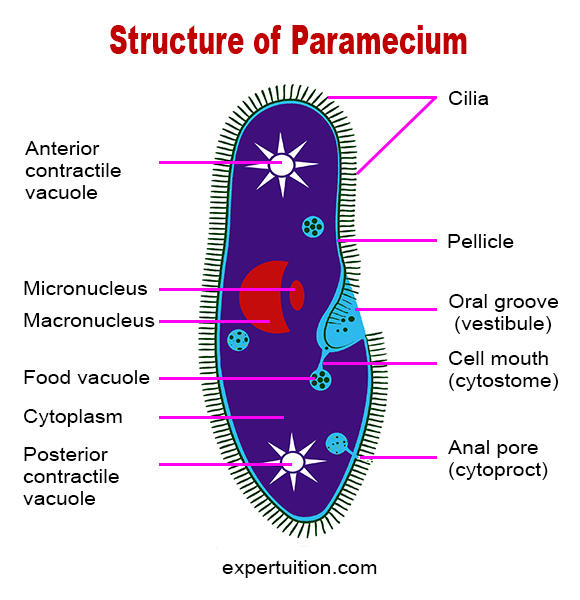
Movement in Paramecium
Paramecium moves using cilia. The cilia beat rhythmically (repeatedly at regular intervals) to propel the cell through its surroundings.
The cell can move in a reverse direction by reversing the motion of the cilia.
Reproduction in Paramecium
The most common type of reproduction in Paramecium is asexual by transverse binary fission and occurs under favorable conditions.
Frequently, Paramecium reproduces sexually by conjugation between binary fission to ensure the continued vitality of the species.
Asexual Reproduction / Transverse Binary Fission
In binary fission, a parent cell divides into two identical daughter cells.
The two nuclei in the cell first divide simultaneously.
Micronucleus divides by mitosis. The two new micronuclei move in the opposite direction.
There is an amitotic division of the macronucleus by elongating and constricting in the middle.
The original oral groove disappears and two new ones are formed, with one at each end of the cell.
Each of the two original contractile vacuoles remains at each end of the dividing cell, and two new ones are formed.
Constriction furrows form at the middle of the cell and completely divide the cell into two daughter cells with identical organelles.
These identical cells are called a clone. The daughter cell formed from the posterior end of the parent cell is called opisthe, and one from the anterior end is called proter.
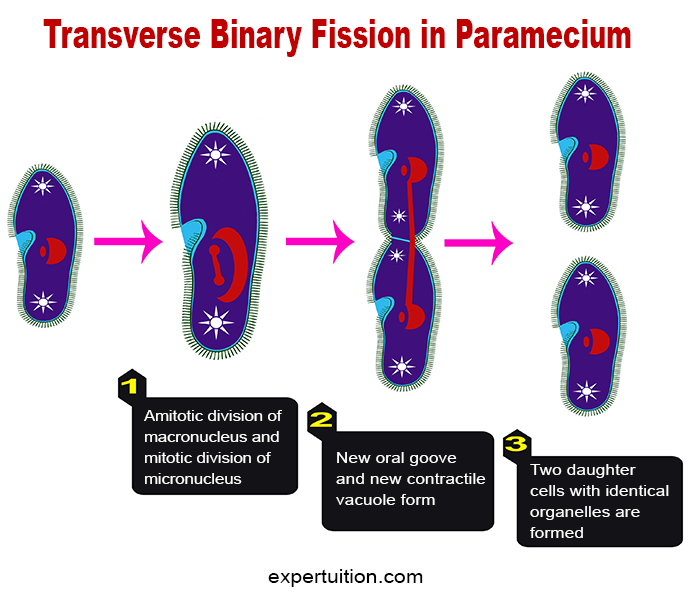
Sexual Reproduction / Conjugation
During conjugation, two cells of different mating types exchange genetic material through direct cell-to-cell contact.
The cells first join their oral surfaces to form a cytoplasmic bridge.
The diploid micronucleus in each cell undergoes meiosis to produce four haploid micronuclei.
Three of the four haploid micronuclei in each cell disintegrate. The remaining one micronucleus in each cell divides by mitosis to give two micronuclei.
The cells then swap one of the micronuclei through the cytoplasmic bridge. The cells separate after exchanging genetic material.
The two micronuclei in each cell fuse to form a diploid micronucleus.
The micronucleus undergoes three rounds of mitosis that result in the formation of eight micronuclei.
The original macronucleus disintegrates, and four of the eight micronuclei become macronuclei.
The cell finally undergoes two rounds of cell division to produce four daughter cells.
Thus, each of the two cells produces four daughter cells at the end of the conjugation process.

Nutrition / feeding in Paramecium
Paramecium is an animal-like protist and therefore cannot produce its food.
It obtains energy by ingesting and digesting food. This type of feeding is known as holozoic nutrition.
During feeding, the cell uses cilia located in the oral groove to sweep food together with water into the mouth pore to form a food vacuole.
The food vacuole breaks off when there are enough food particles in it.
Paramecium has a moving cytoplasm known as cyclosis. The food vacuole travels through the moving cytoplasm allowing enzymes to be released into the food vacuole to digest the food.
Nutrients from the digested food diffuse into the cytoplasm.
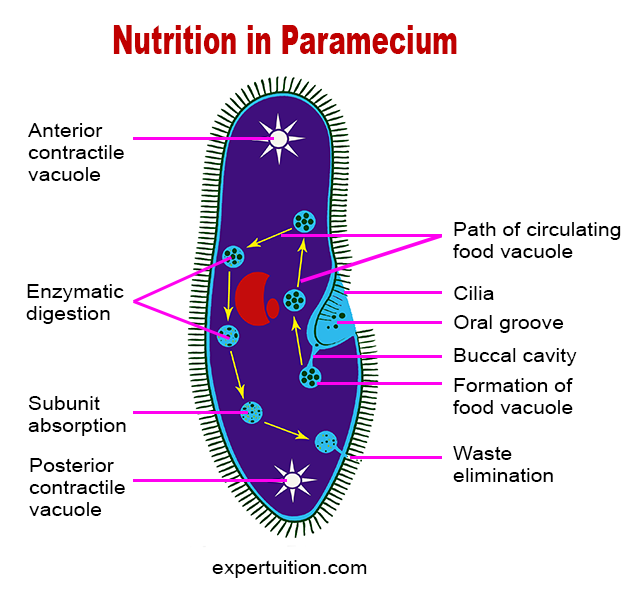
Excretion and Osmoregulation
Excretion is the removal of wastes from the cell.
Paramecium removes insoluble or solid wastes from digestion through the anal pore.
Soluble or liquid wastes diffuse to the surrounding environment through the cell membrane by the action of the contractile vacuoles.
The star-shaped contractile vacuoles also collect and expel excess water to maintain an internal balance between water and dissolved materials. This is known as osmoregulation.
Respiration in Paramecium
Paramecium exchanges dissolved gases with its environment through the cell membrane by diffusion.
The cell takes in oxygen while carbon dioxide diffuses out.
Response
Paramecium responds to touch, chemicals, and other stimuli. This results in a change in speed or direction.
Paramecium has tiny organelles under the pellicle called trichocysts.
When the cell senses any danger from predators, the trichocysts discharge stiff filaments into the surrounding water as a defense mechanism.
Conclusion
Paramecium is a well-known ciliate in Kingdom Protista.
It moves and feeds with the help of small hair-like structures called cilia.
It reproduces asexually by transverse binary fission and sexually by conjugation.
Paramecium also performs other life activities such as removal of waste, response to stimuli, and more.
Protists Notes & Assessment
If you’re looking for resources to review or assess students’ knowledge of Amoeba, Paramecium and Euglena, my protists products will be the perfect fit for you.
You can get these products from my TPT store or my WooCommerce shop.

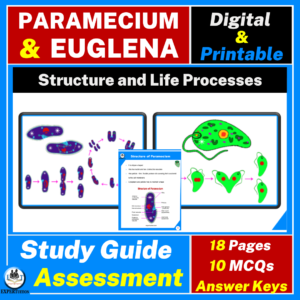
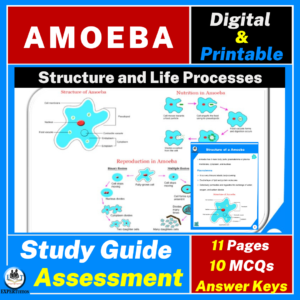
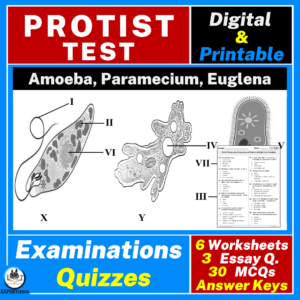


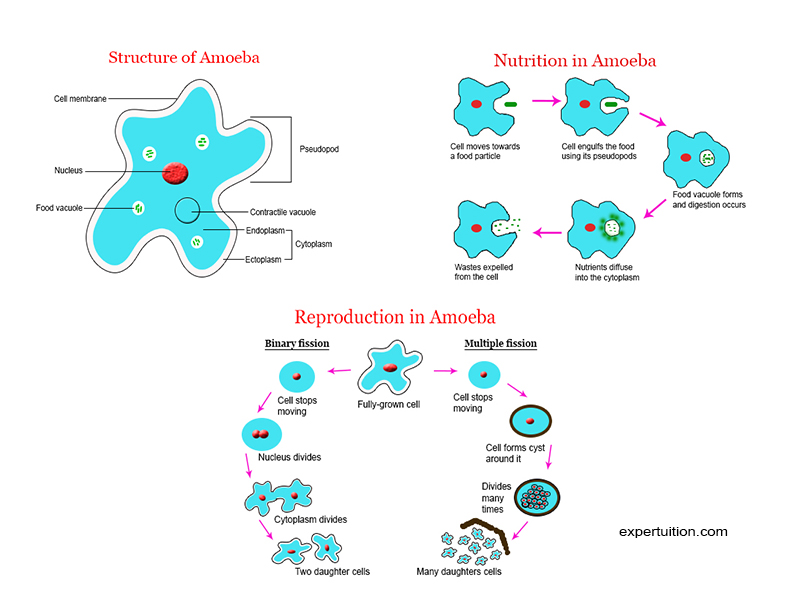
Woah! I’m really loving the template/theme of this blog. It’s simple, yet effective. A lot of times it’s challenging to get that “perfect balance” between superb usability and appearance. I must say you have done a amazing job with this. Also, the blog loads super fast for me on Safari. Superb Blog!